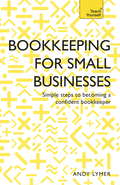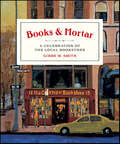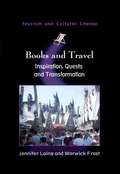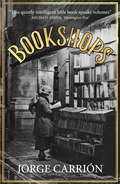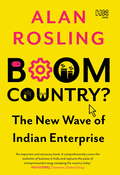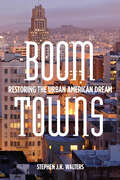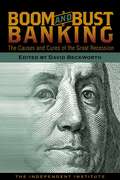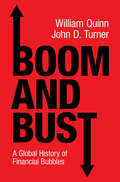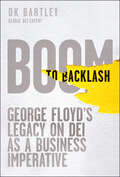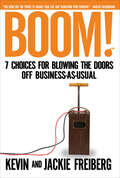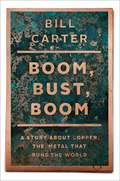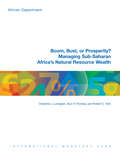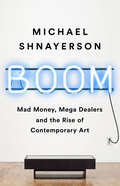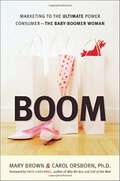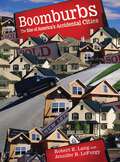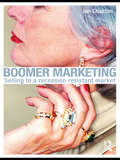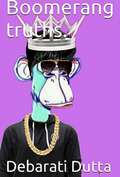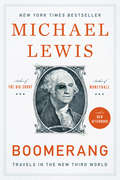- Table View
- List View
Bookkeeping for Small Businesses: Simple steps to becoming a confident bookkeeper
by Nick Rowbottom Andy LymerIs this the right book for me?Book keeping is neither dull nor mysterious - its rules are logical and straightforward and are readily mastered by practice. Successful Bookkeeping for Small Business is a substantial yet easy to follow introduction to the principles of bookkeeping and the practical skills of recording transactions, posting the ledgers and preparing final accounts.Written by finance and accounting experts from the University of Birmingham this book: - Explains the purpose and use of books of original entry as the basis of the double-entry system. - Describes the processes of recording purchases, sales and cash transactions. - Shows how these records are used to prepare the final accounts, the manufacturing, trading and profit and loss accounts and the balance sheet to provide accurate financial statements. - Explores petty cash, depreciation, partnership, company law, business documents and the effect of changes in IT.Worked examples throughout allow you to put the theory into practice. There is also a wide range of carefully graded questions and exercises with sample answers. In short, it demystifies the art of bookkeeping and gives you the confidence you need to tackle your books.Successful Bookkeeping for Small Business includes:Chapter 1: What is book keeping?Chapter 2: Business documentsChapter 3: The business transaction, purchases and salesChapter 4: Purchase and sales transactions and ledger accountsChapter 5: Cash transactionsChapter 6: The bank reconciliationChapter 7: Petty cashChapter 8: The (general) journalChapter 9: Writing up the booksChapter 10: The trial balanceChapter 11: What is profit or loss?Chapter 12: The revenue account: the trading, profit and loss and appropriation accountsChapter 13: The balance sheetChapter 14: Adjustments in the final accountsChapter 15: DepreciationChapter 16: Clubs, societies and charities book keepingChapter 17: Information technology and book keepingChapter 18: PartnershipsChapter 19: Limited companiesChapter 20: The analysis and interpretations of accountsLearn effortlessly with a new easy-to-read page design and added features:Not got much time?One, five and ten-minute introductions to key principles to get you started.Author insightsLots of instant help with common problems and quick tips for success, based on the authors' many years of experience.Test yourselfTests in the book and online to keep track of your progress.Extend your knowledgeExtra online articles to give you a richer understanding of bookkeeping.Try thisInnovative exercises illustrate what you've learnt and how to use it.
Books & Mortar: A Celebration of the Local Bookstore
by Gibbs M. SmithThe local bookstore, a place of wonder, refuge, and rejuvenation for book lovers the world over. Books & Mortar is a celebration of these literary strongholds. Sixty-eight oil paintings capture these storefronts at a moment in time, and pair the artwork with anecdotes about the shops and reflections on bookselling by many of the owners themselves. A delightful gift for an avid reader, an inspiration for any bookstore owner, Books & Mortar is the perfect keepsake for anyone’s personal library.
Books and Travel
by Warwick Frost Jennifer LaingThe books that we read, whether travel-focused or not, may influence the way in which we understand the process or experience of travel. This multidisciplinary work provides a critical analysis of the inspirational and transformational role that books play in travel imaginings. Does reading a book encourage us to think of travel as exotic, adventurous, transformative, dangerous or educative? Do different genres of books influence a reader's view of travel in multifarious ways? These questions are explored through a literary analysis of an eclectic selection of books spanning the period from the eighteenth century to the present day. Genres covered include historical fiction, children's books, westerns, science-fiction and crime fiction.
Bookshops
by Jorge Carrión"A lot of people will be interested in the famous bookshops of the world: Jorge Carrión has gone and visited them all. We can't travel right now, but we can travel in books." MARGARET ATWOODWhy do bookshops matter? How do they filter our ideas and literature? In this inventive and highly entertaining extended essay, Jorge Carrion takes his reader on a journey around the world, via its bookshops. His travels take him to Shakespeare & Co in Paris, Wells in Winchester, Green Apple Books in San Francisco, Librairie des Colonnes in Tangier, the Strand Book Store in New York and provoke encounters with thinkers, poets, dreamers, revolutionaries and readers. Bookshops is the travelogue of a lucid and curious observer, filled with anecdotes and stories from the universe of writing, publishing and selling books. A bookshop in Carrion's eyes never just a place for material transaction; it is a meeting place for people and their ideas, a setting for world changing encounters, a space that can transform lives.Written in the midst of a worldwide recession, Bookshops examines the role of these spaces in today's evershifting climate of globalisation, vanishing high streets, e-readers and Amazon. But far from taking a pessimistic view of the future of the physical bookshop, Carrion makes a compelling case for hope, underlining the importance of these places and the magic that can happen there. A vital manifesto for the future of the traditional bookshop, and a delight for all who love them.Translated from the Spanish by Peter Bush
Bookshops
by Jorge CarriónWhy do bookshops matter? How do they filter our ideas and literature? In this inventive and highly entertaining extended essay, Jorge Carrion takes his reader on a journey around the world, via its bookshops. His travels take him to Shakespeare & Co in Paris, Wells in Winchester, Green Apple Books in San Francisco, Librairie des Colonnes in Tangier, the Strand Book Store in New York and provoke encounters with thinkers, poets, dreamers, revolutionaries and readers. Bookshops is the travelogue of a lucid and curious observer, filled with anecdotes and stories from the universe of writing, publishing and selling books. A bookshop in Carrion's eyes never just a place for material transaction; it is a meeting place for people and their ideas, a setting for world changing encounters, a space that can transform lives.Written in the midst of a worldwide recession, Bookshops examines the role of these spaces in today's evershifting climate of globalisation, vanishing high streets, e-readers and Amazon. But far from taking a pessimistic view of the future of the physical bookshop, Carrion makes a compelling case for hope, underlining the importance of these places and the magic that can happen there. A vital manifesto for the future of the traditional bookshop, and a delight for all who love them.(P)2016 WF Howes Ltd
Boom Bust Ology
by Vikram MansharamaniA multi-disciplinary framework through which to spot financial bubbles before they burst. Based on a popular undergraduate seminar, entitled Financial Booms & Busts, taught by the author at Yale University, Boombustology presents a multi-disciplinary framework for identifying unsustainable booms and forthcoming busts. The magnitude of our recent financial crisis mandates a firm understanding of this phenomenon before the next crisis occurs. Boombustology provides an in-depth look at several major booms and busts and offers a solid framework for thinking about future occurrences. Examines why booms and busts are not random and can therefore be identified Focuses upon various theoretical and disciplinary lenses useful in the study of booms and busts Contains a framework for thinking about and identifying forthcoming financial bubbles including several tell-tale indicators of a forthcoming bust. Illustrates the framework in action by evaluating China as a potential bubble in the making. If you want to make better decisions in today's turbulent investment environment, understanding the dynamics of booms and busts is the best place the start. Boombustology can help you achieve this elusive goal. Vikram Mansharamani is a Lecturer at Yale University and a global equity investor.
Boom Country?: The New Wave of Indian Entrepreneurship
by Alan RoslingIn Boom Country?, Alan Rosling, entrepreneur and strategic advisor in India for over 35 years, explores an unmistakable and profound change that is underway in the Indian business landscape. A fresh wave of enterprise and start-ups; rapid advancements in technology; government reform; and recently developed pools of risk capital, he holds, are contributing increasingly to a massive expansion in new business ? all of it underpinned by a deep social change, a willingness to `do things differently?, especially among the young. Drawing upon his own experiences and more than 100 interviews with Indian entrepreneurs ? representing traditional leading business houses (Tata, Mahindra and Godrej), established first-generation entrepreneurs (Sunil Mittal, Kishore Biyani and Narayana Murthy, among others) and new-generation start-ups (including Sachin Bansal, Bhavish Aggarwal and Vijay Shekhar Sharma) ? as well as forces of the government, Rosling provides an incisive and in-depth analysis of the opportunities and challenges, both traditional and contemporary, of doing business in India. Yet, the growing uncertainty of global trends and India?s own record of under-performing despite its massive potential, lead him to one vital question: Can the current upsurge in entrepreneurial activity ? imperfect and early as it may be ? really reshape India?s economy and propel it towards becoming a true boom country for new enterprise?
Boom Town Blues: Collapse and Revival in a Single-Industry Community
by Anne-Marie Mawhiney Jane PitbladoBoom Town Blues: Collapse and Revival in a Single-Industry Community tells of the Northern Ontario city of Elliot Lake, once the uranium capital of the world, which was devastated by the closing of the uranium mines operated by Denison and Rio Algom. The closures and mass layoffs were first announced in 1990 with the layoffs occurring from then until June 1996. Throughout the period after the layoffs were announced, several major research projects were undertaken. One, the Elliot Lake Tracking and Adjustment Study, follows approximately 1,000 of the laid-off miners and 530 of their spouses through their adjustment processes. Another, the Seniors Needs Assessment, examines the human resource and service needs of the increasing numbers of seniors moving to Elliot Lake as part of the community’s economic strategy. In addition to these social scientific studies, several land and environmental reclamation research projects have been undertaken. Boom Town Blues: Collapse and Revival in a Single-Industry Community tells the reader about the results of these studies and gives a variety of community-based perspectives on the Elliot Lake story. The book highlights the struggles and successes of families and of the community as a whole. Boom Town Blues is about one community’s struggle to survive, to shift its economic base from mining to one where retirement living for seniors, mine decommissioning, and a community-based research facility would be among several economic survival strategies. The book is of interest to readers throughout Northern Ontario and, indeed, wherever single-industry towns are threatened by major shifting in their economic base and are struggling to survive. The book also provides an excellent case study for teachers, students, policy makers, and politicians.
Boom Towns: Restoring the Urban American Dream
by Stephen J.K. WaltersAmerican cities, once economic and social launch pads for their residents, are all too often plagued by poverty and decay. One need only to look at the ruins of Detroit to see how far some once-great cities have fallen, or at Boston and San Francisco for evidence that such decline is reversible. In Boom Towns, Stephen J.K. Walters diagnoses the root causes of urban decline in order to prescribe remedies that will enable cities to thrive once again. Arguing that commonplace explanations for urban decay misunderstand the nature our towns, Walters reconceives of cities as dense accumulations of capital in all of its forms—places that attract people by making their labor more productive and their leisure more pleasurable. Policymakers, therefore, must properly define and enforce property rights in order to prevent the flight of capital and the resulting demise of urban centers. Using vivid evocations of iconic towns and the people who crucially affected their destinies, Walters shows how public policy measures which aim to revitalize often do more harm than good. He then outlines a more promising set of policies to remedy the capital shortage that continues to afflict many cities and needlessly limit their residents' opportunities. With its fresh interpretation of one of the American quandaries of our day,Boom Towns offers a novel contribution to the debate about American cities and a program for their restoration.
Boom and Bust Banking: The Causes and Cures of the Great Recession
by David M. BeckworthExploring the forceful renewal of the boom-and-bust cycle after several decades of economic stability, this book is a research-based review of the factors that caused the 2008 recession. It offers cutting-edge diagnoses of the recession and prescriptions on how to boost the economy from leading economists.Congress created the Federal Reserve System in 1913 to tame the business cycle once and for all. Optimists believed central banking would moderate booms, soften busts, and place the economy on a steady trajectory of economic growth. A century later, in the wake of the worst recession in fifty years, Editor David Beckworth and his line-up of noted economists chronicle the critical role the Federal Reserve played in creating a vast speculative bubble in housing during the 2000s and plunging the world economy into a Great Recession. As commentators weigh the culpability of Wall Street&’s banks against Washington&’s regulators, the authors return our attention to the unique position of the Federal Reserve in recent economic history. Expansionary monetary policy formed the basis of the soaring housing prices, excessive leverage, and mispricing of risk that characterized the Great Boom and the conditions for recession. Yet as Boom and Bust Banking also explains, the Great Recession was not an inevitable result of the Great Boom. Contrary to the conventional wisdom, the Federal Reserve in fact tightened rather than loosened the money supply in the early days of the recession. Addressing a lack of critical studies of recent Federal Reserve policy, Boom and Bust Banking reveals the Federal Reserve&’s hand in the economy&’s deterioration from slowdown to global recession. At the close of the most destructive economic episode in a half-century, Boom and Bust Banking reconsiders the justifications for central banking and reflects on possibilities for reform. With the future ripe for new thinking, this volume is essential for policy makers and concerned citizens who wish to learn from recent history.
Boom and Bust: A Global History of Financial Bubbles
by John D. Turner William QuinnWhy do stock and housing markets sometimes experience amazing booms followed by massive busts and why is this happening more and more frequently? In order to answer these questions, William Quinn and John D. Turner take us on a riveting ride through the history of financial bubbles, visiting, among other places, Paris and London in 1720, Latin America in the 1820s, Melbourne in the 1880s, New York in the 1920s, Tokyo in the 1980s, Silicon Valley in the 1990s and Shanghai in the 2000s. As they do so, they help us understand why bubbles happen, and why some have catastrophic economic, social and political consequences whilst others have actually benefited society. They reveal that bubbles start when investors and speculators react to new technology or political initiatives, showing that our ability to predict future bubbles will ultimately come down to being able to predict these sparks.
Boom and Bust: The rise and fall of the mining industry, greed and the impact on everyday Australians
by Royce KurmelovsThis is a cautionary tale. About greed, irresponsibility and failing to learn from the past.Australia's mining boom is still talked about with a sense of awe. This once-in-a-lifetime event capped off 25 straight years of economic growth. Thanks to mining we sidestepped the worst of the Global Financial Crisis. To the rest of the world Australia was an economic miracle. And then the boom ended.Now Australia is grappling with what that means at a time of rising economic inequality and political upheaval. The end of the boom isn't about money - it's about people. Boom and Bust looks at what happens to those who came into vast wealth only to watch it dry up. To those who thought they had a good job for life, but didn't. The bust didn't just happen on stock-market screens - it was lived, and is still being lived right now, in dusty towns and cities all around the country.As he did in his bestselling book The Death of Holden, Royce Kurmelovs reveals the reality behind the headlines. Boom and Bust is a dirt-under-the-nails look at the winners, the losers and the impact of the boom that wasn't meant to end. This is a book all Australians should read.'Brilliant and powerful' Nick Xenophon on Royce Kurmelovs' THE DEATH OF HOLDEN
Boom to Backlash: George Floyd's Legacy on DEI as a Business Imperative
by DK BartleyHow the murder of George Floyd transformed the attitude towards and implementation of DEI across the world Boom to Backlash: George Floyd's Legacy on DEI as a Business Imperative examines the seismic shift in DEI initiatives following George Floyd's completely preventable death, exploring the initial surge of corporate commitments to DEI, the tangible progress and advancements made, and the subsequent backlash. Through data and case studies, as well as the unparalleled personal experiences of Black executive, global DEI expert, and author DK Bartley, this book illustrates how DEI has evolved from a fringe concept to a crucial element of business strategy, corporate success, and social progress. Some of the topics explored in this book include: The mischaracterization of DEI as “new” or “woke” by various platforms The real impact of DEI on a business's bottom line The future of DEI with respect to the current political climate and technology's role in implementation strategies Why George Floyd's murder was a catalyst for change By addressing these critical aspects of DEI within the context of recent historical events, Boom to Backlash engages with a growing audience of business and political leaders, social media influencers, HR professionals, and individuals who want to understand and implement effective DEI strategies in a post-2020 world.
Boom!: 7 Choices for Blowing the Doors Off Business-As-Usual
by Kevin Freiberg Jackie FreibergUsing twenty years of wisdom distilled into seven choices, two bestselling authors show how to become impassioned, engaged, and indispensable at work.When you realize your career is a result of choices, and not conditions, the effect is absolutely liberating. You begin to think big and act bold. You become impassioned and engaged. Coworkers look to you for leadership and inspiration. You close the gap between the corporate culture you envision and the one in which you work. You become indispensable on the job.After twenty years of talking to America’s most innovative and unconventional business leaders and liberated employees, the Freibergs have distilled this collective wisdom into seven essential choices. If you’re ready to move from a life stuck in neutral to the freedom of seeing work as an exciting and passionate adventure, then BOOM! is your ticket. Expand your influence and engage in work that matters!Are you tired of blaming your unhappiness and lack of job satisfaction on others? Then it’s time to read Choice #2: Be Accountable—There Is No “THEY”—Only You and Me.Are you constantly asking negative, defensive questions like “Why is this happening to me?” Then it’s time to make Choice #4 Focus Forward—Your Future Is Not in the Rearview Mirror.Are you always tempted to play it safe and stay within your tightly define comfort zone? Then it’s time to embrace Choice #7: Risk More/Gain More—The World Isn’t Changed by Those Who Are Unwilling to Take Risks.Leadership doesn’t come from having an official title but from making choices: to serve others, take on risk, assume responsibility and discover a life where passion and excitement replace ho-hum routine. BOOM! is a wake-up call for every person who wants to make a difference and every business leader who wants to change the DNA of an organization doing business as usual.Praise for BOOM!“Every leader asks, ‘How can we motivate our people?’ The Freibergs get to the heart of what it takes to create engaged, indispensable, and results-oriented employees one choice at a time.” —Richard Floersch, Executive VP Worldwide HR, McDonald’s Corporation“In this breezy but helpful book, the Freibergs deliver with easy-to-act-on ideas and their spirited and irreverent voice. Make the choice to read it, and put yourself on course.” —Tim Sanders, author of Love is the Killer App: How to Win Business and Influence Friends
Boom, Bust, Boom: A Story About Copper, the Metal that Runs the World
by Bill CarterFrom “a first-rate writer in the fascinating tradition of Junger and Krakauer” (Jim Harrison, author of Legends of the Fall), a sweeping account of civilization’s complete dependence on copper and what it all means for people, nature, and the global economy.A SWEEPING ACCOUNT OF CIVILIZATION’S COMPLETE DEPENDENCE ON COPPER AND WHAT IT MEANS FOR PEOPLE, NATURE, AND OUR GLOBAL ECONOMY COPPER is a miraculous and contradictory metal, essential to nearly every human enterprise. For most of recorded history, this remarkably pliable and sturdy substance has proven invaluable: not only did the ancient Romans build their empire on mining copper but Christopher Columbus protected his ships from rot by lining their hulls with it. Today, the metal can be found in every house, car, airplane, cell phone, computer, and home appliance the world over, including in all the new, so-called green technologies. Yet the history of copper extraction and our present relationship with the metal are fraught with profound difficulties. Copper mining causes irrevocable damage to the Earth, releasing arsenic, cyanide, sulfuric acid, and other deadly pollutants into the air and water. And the mines themselves have significant effects on the economies and wellbeing of the communities where they are located. With Red Summer and Fools Rush In, Bill Carter has earned a reputation as an on-the-ground journalist adept at connecting the local elements of a story to its largest consequences. Carter does this again—and brilliantly—in Boom, Bust, Boom, exploring in an entertaining and fact-rich narrative the very human dimension of copper extraction and the colossal implications the industry has for every one of us. Starting in his own backyard in the old mining town of Bisbee, Arizona—where he discovers that the dirt in his garden contains double the acceptable level of arsenic—Bill Carter follows the story of copper to the controversial Grasberg copper mine in Indonesia; to the “ring” at the London Metal Exchange, where a select group of traders buy and sell enormous amounts of the metal; and to an Alaskan salmon run threatened by mining. Boom, Bust, Boom is a highly readable account—part social history, part mining-town exploration, and part environmental investigation. Page by page, Carter blends the personal and the international in a narrative that helps us understand the paradoxical relationship we have with a substance whose necessity to civilization costs the environment and the people who mine it dearly. The result is a work of first-rate journalism that fascinates on every level.
Boom, Bust, or Prosperity? Managing Sub-Saharan Africa's Natural Resource Wealth
by Alun H. Thomas Robert C. York Charlotte J. LundgrenSizeable natural resource endowments and potentially large financial inflows from their extraction provide an unparalleled opportunity for economic growth and development in a growing number of sub-Saharan African countries. Empirical evidence suggests, however, that translating this resource wealth into stronger economic performance and a higher standard of living has proven challenging. Much has been written about the resource curse. This publication focuses on solutions to the challenges and outlines the main policy considerations and options in managing natural resource wealth, drawing on experience within and outside sub-Saharan Africa and referring closely to the latest analysis and policy advice in this area by the IMF, the World Bank, and leading academic research. A key feature of each chapter is a recommended reading list for those who wish additional, more in-depth material on these issues to further inform policymakers and other stakeholders on the theoretical and analytical underpinnings of the policy advice.
Boom-Bust Cycle, Asymmetrical Fiscal Response and the Dutch Disease
by Kareem Ismail Rabah ArezkiA report from the International Monetary Fund.
Boom: Mad Money, Mega Dealers, and the Rise of Contemporary Art
by Michael ShnayersonThe meteoric rise of the largest unregulated financial market in the world-for contemporary art-is driven by a few passionate, guileful, and very hard-nosed dealers. They can make and break careers and fortunes. <P><P>The contemporary art market is an international juggernaut, throwing off multimillion-dollar deals as wealthy buyers move from fair to fair, auction to auction, party to glittering party. <P><P> But none of it would happen without the dealers-the tastemakers who back emerging artists and steer them to success, often to see them picked off by a rival. Dealers operate within a private world of handshake agreements, negotiating for the highest commissions. <P><P>Michael Shnayerson, a longtime contributing editor to Vanity Fair, writes the first ever definitive history of their activities. He has spoken to all of today's so-called mega dealers-Larry Gagosian, David Zwirner, Arne and Marc Glimcher, and Iwan Wirth-along with dozens of other dealers-from Irving Blum to Gavin Brown-who worked with the greatest artists of their times: Jackson Pollock, Andy Warhol, Cy Twombly, and more. <P><P>This kaleidoscopic history begins in the mid-1940s in genteel poverty with a scattering of galleries in midtown Manhattan, takes us through the ramshackle 1950s studios of Coenties Slip, the hipster locations in SoHo and Chelsea, London's Bond Street, and across the terraces of Art Basel until today. <P><P>Now, dealers and auctioneers are seeking the first billion-dollar painting. It hasn't happened yet, but they are confident they can push the price there soon.
Boom: Marketing to the Ultimate Power Consumer—The Baby-Boomer Woman
by Mary Brown Carol OrsbornForeword by Paco Underhill Women make the vast majority of purchasing decisions in the United States, spending trillions of dollars every year on everything from food and clothing to appliances, cars, vacations, real estate, and much more. One huge, affluent segment of that demographic wields more spending clout than any other: Baby-Boomer women. Born between 1946 and 1964, these women represent a portion of the buying public no marketer can afford to ignore. With successful careers, investments made during the "boom" years, and inheritances from parents or husbands, they are more financially empowered than any previous generation of women. But what is it that will make these women spend their money on your products? Meet Mary Brown and Carol Orsborn, whose exclusive business it is to find out what makes Baby-Boomer women tick -- and buy. With BOOM, they reveal the results of proprietary research that has helped their firm’s five-star clients outclass the competition by reaching and resonating with this powerhouse demographic. BOOM brings together the insights of dozens of market leaders in a wide array of industries, insiders who have learned (sometimes the hard way) what works and what doesn’t in the battle for the hearts and minds of the ""ultimate power consumer."" You will learn: How to increase your market share of today’s most lucrative consumer demographic What your competition and other industry leaders are doing to reach Baby- Boomer women How to minimize the risks and maximize the potential of your efforts in this market How to find, interpret, and present information and statistics and build a strong business case to your colleagues, shareholders, company executives, and others Intelligence for making savvy decisions and communicating the clear message that your target customer wants to hear You’ll also get the authors’ exclusive Imago Diagnostic (ID) tool for identifying exactly what resonates with Boomer women, along with the Seven Things You Don’t Know About Baby-Boomer Women (But Should). At the age when they are more financially comfortable than ever, Baby-Boomer women are now poised and energized to drive consumer markets to unbelievable new highs. With the eye-opening information and cutting-edge strategies in BOOM, your company will be set to enjoy an amazing ride to the top.
Boomburbs
by Robert E. Lang Jennifer B. LefurgyA glance at a list of America's fastest growing "cities" reveals quite a surprise: most are really overgrown suburbs. Places such as Anaheim, California, Coral Springs, Florida, Naperville, Illinois, North Las Vegas, Nevada, and Plano, Texas, have swelled to big-city size with few people really noticing--including many of their ten million residents. These "boomburbs" are large, rapidly growing, incorporated communities of more than 100,000 residents that are not the biggest city in their region. Here, Robert E. Lang and Jennifer B. LeFurgy explain who lives in them, what they look like, how they are governed, and why their rise calls into question the definition of urban.Located in over twenty-five major metro areas throughout the United States, numerous boomburbs have doubled, tripled, even quadrupled in size between census reports. Some are now more populated than traditional big cities. The population of the biggest boomburb--Mesa, Arizona--recently surpassed that of Minneapolis and Miami.Typically large and sprawling, boomburbs are "accidental cities," but not because they lack planning. Many are made up of master-planned communities that have grown into one another. Few anticipated becoming big cities and unintentionally arrived at their status. Although boomburbs possess elements found in cities such as housing, retailing, offices, and entertainment, they lack large downtowns. But they can contain high-profile industries and entertainment venues: the Los Angeles Angels of Anaheim and Arizona Cardinals are among over a dozen major-league sports teams who play in the boomburbs.Urban in fact but not in feel, these drive-by cities of highways, office parks, and shopping malls are much more horizontally built and less pedestrian friendly than most older suburbs. And, contrary to common perceptions of suburbia, they are not rich and elitist. Poverty is often seen in boomburb communities of small single-family homes, neighborhoods that once represented the American dream. Boomburbs are a quintessential American landscape, embodying much of the nation's complexity, expansiveness, and ambiguity. This fascinating look at the often contradictory world of boomburbs examines why America's suburbs are thriving and how they are shaping the lives of millions of residents.
Boomburbs
by Robert E. Lang Jennifer B. LefurgyA glance at a list of America's fastest growing "cities" reveals quite a surprise: most are really overgrown suburbs. Places such as Anaheim, California, Coral Springs, Florida, Naperville, Illinois, North Las Vegas, Nevada, and Plano, Texas, have swelled to big-city size with few people really noticing-including many of their ten million residents. These "boomburbs" are large, rapidly growing, incorporated communities of more than 100,000 residents that are not the biggest city in their region. Here, Robert E. Lang and Jennifer B. LeFurgy explain who lives in them, what they look like, how they are governed, and why their rise calls into question the definition of urban.Located in over twenty-five major metro areas throughout the United States, numerous boomburbs have doubled, tripled, even quadrupled in size between census reports. Some are now more populated than traditional big cities. The population of the biggest boomburb-Mesa, Arizona-recently surpassed that of Minneapolis and Miami.Typically large and sprawling, boomburbs are "accidental cities," but not because they lack planning. Many are made up of master-planned communities that have grown into one another. Few anticipated becoming big cities and unintentionally arrived at their status. Although boomburbs possess elements found in cities such as housing, retailing, offices, and entertainment, they lack large downtowns. But they can contain high-profile industries and entertainment venues: the Los Angeles Angels of Anaheim and Arizona Cardinals are among over a dozen major-league sports teams who play in the boomburbs.Urban in fact but not in feel, these drive-by cities of highways, office parks, and shopping malls are much more horizontally built and less pedestrian friendly than most older suburbs. And, contrary to common perceptions of suburbia, they are not rich and elitist. Poverty is often seen in boomburb communities of small single-family homes, neighborhoods that once represented the American dream.Boomburbs are a quintessential American landscape, embodying much of the nation's complexity, expansiveness, and ambiguity. This fascinating look at the often contradictory world of boomburbs examines why America's suburbs are thriving and how they are shaping the lives of millions of residents.
Boombustology: Spotting Financial Bubbles Before They Burst
by Vikram MansharamaniThe new, fully-updated edition of the respected guide to understanding financial extremes, evaluating investment opportunities, and identifying future bubbles Now in its second edition, Boombustology is an authoritative, up-to-date guide on the history of booms, busts, and financial cycles. Engaging and accessible, this popular book helps investors, policymakers, and analysts navigate the radical uncertainty that plagues today’s uncertain investing and economic environment. Author Vikram Mansharamani, an experienced global equity investor and prominent Harvard University lecturer, presents his multi-disciplinary framework for identifying financial bubbles before they burst. Moving beyond the typical view of booms and busts as primarily economic occurrences, this innovative book offers a multidisciplinary approach that utilizes microeconomic, macroeconomic, psychological, political, and biological lenses to spot unsustainable dynamics. It gives the reader insights into the dynamics that cause soaring financial markets to crash. Cases studies range from the 17th Century Dutch tulip mania to the more recent US housing collapse. The numerous cross-currents driving today’s markets—trade wars, inverted yield curves, currency wars, economic slowdowns, dangerous debt dynamics, populism, nationalism, as well as the general uncertainties in the global economy—demand that investors, policymakers, and analysts be on the lookout for a forthcoming recession, market correction, or worse. An essential resource for anyone interested in financial markets, the second edition of Boombustology: Adopts multiple lenses to understand the dynamics of booms, busts, bubbles, manias, crashes Utilizes the common characteristics of past bubbles to assist in identifying future financial extremes Presents a set of practical indicators that point to a financial bubble, enabling readers to gauge the likelihood of an unsustainable boom Offers two new chapters that analyze the long-term prospects for Indian markets and the distortions being caused by the passive investing boom Includes a new foreword by James Grant, legendary editor of Grant's Interest Rate Observer A comprehensive exploration of how bubbles form and why they burst, Boombustology, 2nd Edition is packed with a wealth of new and updated information for individual and institutional investors, academics, students, policymakers, risk-managers, and corporate managers alike.
Boomer Marketing: Selling to a Recession Resistant Market
by Ian ChastonBaby boomers (consumers in the 50+ age bracket) are the wealthiest, fastest growing consumer group in the world. Despite this, the vast majority of marketing spend is focused on much younger people. Recessions always dampen consumer spending, but in the 21st century’s first recession, the decline in spending among the younger age group has been amplified by excessive borrowing and collapsing house prices. More so than ever before, the current global recession highlights the need for firms to revise their marketing strategies and practices in order to remain competitive. In this book, Ian Chaston uses original case material to propose strategic solutions that take advantage of the moneyed segments of the maturing boomer market. Key topics covered include: Marketing errors made by UK banks in the current global crisis Market research Customer targeting Marketing strategies and pricing innovation Promotion and distribution A world first, Boomer Marketing is useful for students of marketing and consumer behaviour and is essential reading for practitioners who understand the need for money-oriented marketing. Additional lecturer material available at www.routledge.com/9780415489638
Boomerang truths.
by Debarati DuttaAI equipment have revolutionized the way we work. They can assist automate mundane tasks, limit time taken to whole complicated duties and enlarge productivity.
Boomerang: Travels In The New Third World
by Michael Lewis“Lewis shows again why he is the leading journalist of his generation.”—Kyle Smith, Forbes The tsunami of cheap credit that rolled across the planet between 2002 and 2008 was more than a simple financial phenomenon: it was temptation, offering entire societies the chance to reveal aspects of their characters they could not normally afford to indulge. Icelanders wanted to stop fishing and become investment bankers. The Greeks wanted to turn their country into a pinata stuffed with cash and allow as many citizens as possible to take a whack at it. The Germans wanted to be even more German; the Irish wanted to stop being Irish. Michael Lewis's investigation of bubbles beyond our shores is so brilliantly, sadly hilarious that it leads the American reader to a comfortable complacency: oh, those foolish foreigners. But when he turns a merciless eye on California and Washington, DC, we see that the narrative is a trap baited with humor, and we understand the reckoning that awaits the greatest and greediest of debtor nations.
